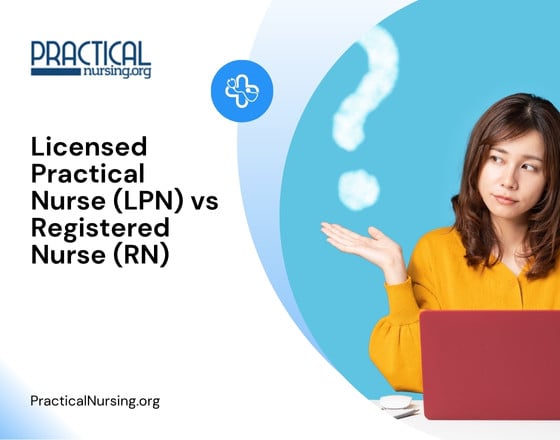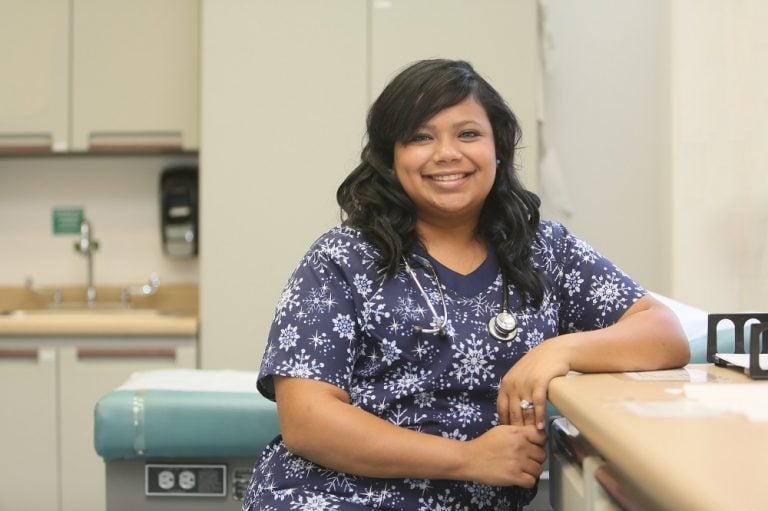Licensed Practical Nurse (LPN) vs Registered Nurse (RN)


 Many people might not know the exact difference between a Licensed Practical Nurse (LPN) and a Registered Nurse (RN). Although both allow for a fulfilling career in nursing and healthcare, when it comes to aspects like job responsibilities, salary, and education – the two are different. Before starting on your educational journey towards a career in nursing, it is a good idea to understand the job responsibilities and career goals of both RNs and LPNs. To sum up, LPNs are responsible for providing more basic nursing care and usually work under the supervision of RNs. RNs on the other hand are generally responsible for administering medicine to patients in addition to creating a treatment plan in order to promote and restore a patient’s health.
Many people might not know the exact difference between a Licensed Practical Nurse (LPN) and a Registered Nurse (RN). Although both allow for a fulfilling career in nursing and healthcare, when it comes to aspects like job responsibilities, salary, and education – the two are different. Before starting on your educational journey towards a career in nursing, it is a good idea to understand the job responsibilities and career goals of both RNs and LPNs. To sum up, LPNs are responsible for providing more basic nursing care and usually work under the supervision of RNs. RNs on the other hand are generally responsible for administering medicine to patients in addition to creating a treatment plan in order to promote and restore a patient’s health.
How Are LPNs Different From Other Nurses?
Licensed practical nurses differ in many ways from other nurses, but their day-to-day duties often consist of similar work. Some of the major differences between LPNs and other nurses include:
Licensed Vocational Nurses (LVNs):
- This is strictly terminology that separates the differences between LVN and LPN titles. LVN terminology is used solely in California & Texas. See below for further explanation.
Certified Nursing Assistants (CNAs):
- Like LPNs, CNAs earn their certificates with one year of coursework and provide basic care for patients. However, they are not considered licensed nurses. CNAs perform their duties under the close supervision of LPNs and RNs. Check out LPN vs CNA or LPN vs Medical Assistant.
Registered Nurses (RNs):
- RNs can complete their coursework and become licensed in two years. Their basic duties are similar to LPNs, although they often receive higher pay, are allowed to perform tests and certain procedures, and are responsible for supervising CNAs and LPNs. Learn more LPN vs RN and read about the LPN to RN transition process. Also see available BSN careers.
Nurse Practitioners (NPs):
- After completing their BSN and MSN degrees, aspiring NPs must pass additional licensing examinations to become fully certified. Licensed NPs have much more freedom than other nurses and are often allowed to write prescriptions and work independently without the supervision of physicians.

LPN vs. RN Education
A big difference between Licensed Practical Nurses and Registered Nurses is the education required. LPN programs tend to focus on the “doing” skills while RN programs focus on both “doing” and “thinking” skills. With that in mind, LPN programs can be completed in less time than RN programs and generally cost less.
RELATED – LPN to RN and Online LPN to RN
It takes about 12 months to complete an LPN program. The shorter time frame is very appealing to many, as it allows passionate individuals the opportunity to quickly delve into the healthcare workforce. Many complete LPN programs at community or technical colleges. As part of an LPN program, LPN candidates will take part in supervised clinical training in order to gain hands experience in the field. In addition to nursing courses, students will also take classes that focus on pharmacology, human anatomy, and biology. LPN programs are very much structured around learning how to perform the necessary skills required to take care of patients.
Check out LPN to ADN and LPN to BSN.
Registered Nursing programs on the other hand take anywhere from 18 to 36 months to complete. RNs must earn a professional nursing degree. The exact length of the program depends on the type of Registered Nursing degree one seeks to obtain. The most common professional nursing degree options for an RN include a BSN (Bachelor of Science in Nursing), an ADN (Associate Degree in Nursing), and a diploma from an accredited nursing program. It is important to keep in mind that in most cases, a BSN is preferred over an ADN and diploma programs. BSN programs usually take about four years to complete. ADN and diploma programs can take about two to three years to complete. Although the three routes vary, it is likely that all will focus on various clinical and hands-on training experiences, as well as classes on behavioral, social, and physical sciences. RN programs will also include courses on team leadership, legal and ethical issues, as well as research and pharmacology.
Learn more about LPN classes, courses, and curriculum.
LPNs who wish to further their careers and gain increased responsibility and pay can enroll in bridge programs. These programs allow for faster transition and certification in new nursing roles. Bridge programs include transitions from CNA to LPN, LPN to ADN, LPN to RN, LPN to RN Online, and LPN to BSN. Several online LPN bridge program options for current LPN’s are available.
Browse LPN/LVN to RN Programs in Your State
Select the state below to see a full list of LPN/LVN to RN bridge programs.
- Alabama
- Alaska
- Arizona
- Arkansas
- California
- Colorado
- Connecticut
- Delaware
- Florida
- Georgia
- Hawaii
- Idaho
- Illinois
- Indiana
- Iowa
- Kansas
- Kentucky
- Louisiana
- Maine
- Maryland
- Massachusetts
- Michigan
- Minnesota
- Mississippi
- Missouri
- Montana
- Nebraska
- Nevada
- New Hampshire
- New Jersey
- New Mexico
- New York
- North Carolina
- North Dakota
- Ohio
- Oklahoma
- Oregon
- Pennsylvania
- Rhode Island
- South Carolina
- South Dakota
- Tennessee
- Texas
- Utah
- Vermont
- Virginia
- Washington
- West Virginia
- Wisconsin
- Wyoming
LPN vs. RN Salary
Licensed Practical Nurses and Registered Nurses will encounter varying salaries depending on their geographic location. Salaries will be affected by a state’s cost of living in addition to how in demand LPN and RN jobs are in that area. In the 2016-2017 Occupational Outlook Handbook (U.S. Bureau of Labor Statistics), the average salary for an LPN is about $42,500 and the median salary for an RN is about $66,500.
RN and LPN salaries vary by area of specialization and years of experience. In most cases, the more years of experience a nurse has the more he or she will earn. Critical care specialties such as the intensive care unit (ICU), emergency department (ED), labor and delivery (L & D), and the operating room (OR) are highly paid specialties in nursing. Normally, there are more crirical care specialty positions available to RNs than LPNs.
Learn more about an LPN salary compared to an RN salary.
LPN vs. RN Job Duties
LPN and RN job responsibilities and duties can differ greatly. As required by law, RNs are responsible for overseeing LPNs. This model will vary by healthcare setting. In a hospital setting, for instance, a Registered Nurse might be assigned to six patients on a medical floor, along with one assigned LPN, and hopefully a CAN (Certified Nursing Assistant) who might be assigned three times as many patients. In this model, the LPN would help the RN administer medication (in most states this will not include IV). The LPN in this model would also assist the RN with wound care and ADLs (activities of daily living). The RN would focus on care plans, charting, updating physicians, and administering medication through IV. In the setting of a skilled nursing facility, the LPN would do all the previously mentioned duties, except IV medications. Meanwhile the RN would oversee the whole facility and all working LPNs.
In general, LPNs are responsible for providing basic nursing care such as checking blood pressure, inserting catheters, and helping comfort patients by performing tasks such as changing and dressing. LPNs work closely with RNs as they are required to report patient statuses to Registered Nurses and doctors.
LPN Job Duties
Licensed Practical Nurses are expected to be proficient in many skills, including the ability to be able to:
- Administer medications (not IV in most States)
- Chart medical records
- Take vital signs
- Change wound dressings
- Collect specimens such as blood and urine
- Insert and caring for urinary catheters
- Care for patients with ventilators and tracheostomy tubes
- Insert and caring for patients with nasogastric tubes
- Provide feedings through nasogastric or gastrostomy tubes
- Monitor patients
- Know when to call appropriate physicians
- Perform emergency CPR
- Execute a nursing care plan formulated by a Registered Nurse (RN)
Learn more about the LPN duties.
RN Job Duties
In addition to all LPN duties mentioned above, some other skill sets for a RN include:
- Administering and monitoring patient medications (including IV)
- Performing BLS (Basic Life Support), ACLS (Advanced Cardiac Life Support), and/or Pediatric Advanced Life Support (PALS)
- Wound care
- Inserting, managing, and discontinuing intravenous catheters and intraurethral catheters
- Developing a plan of care and wellness for each patient
- Properly assessing and managing all patient populations with appropriate intervention
- Taking vital signs as well as recognizing and addressing abnormalities
- Admitting and discharging patients safely and appropriately
- Maintaining accurate documentation
- Safely transferring patients into and out of bed and chair
- Feeding, dressing, and performing hygiene
- Supervising LPNs
- Ensuring patient safety – usually known as “do no harm”, or nonmaleficence
Learn more about LPN careers.
LPN vs. RN Licensing and Certification
Both LPN and RN candidates will be required to pass certain exams in order to become licensed.
Once a state-approved and accredited Practical Nursing program is completed, LPN candidates must pass the National Council Licensure Examination (NCLEX-PN). When the exam is passed, candidates will be able to begin work as a Licensed Practical Nurse.
Registered Nurses are also required to successfully complete a state-approved and accredited nursing program. After a program is completed, candidates must take and pass the National Council Licensure Examination (NCLEX-RN). In addition, some RNs may choose to become certified in specialty areas such as critical care, emergency department, or labor and delivery. This option is usually available after working in a specialty for a certain amount of hours, normally about one year.
Learn more about the NCLEX-PN Exam for Practical Nurses and NCLEX-PN Practice Test Questions
Related Articles
- Complete Guide to LPN/LVN Clinical Rotations: What to Expect and How to Excel
- Diabetes Nurse Educator Careers with BSN
- LPN as Role Model
- 5 Important Qualities to Be an Exceptional LPN
- Pediatric HPV Vaccine – LPN Tips
- Fastest LPN/LVN Programs of 2025: Complete Your Nursing Education in Record Time
- Nursing in Long Term Care
- Licensed Practical Nurse (LPN) vs Certified Nursing Assistant (CNA)